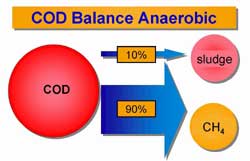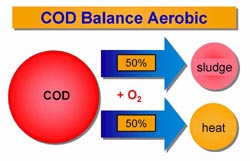Anaerobic Technologies
Anaerobic Wastewater Treatment: Anaerobic wastewater treatment is the biological treatment of wastewater without the use of air or elemental oxygen. Many applications are directed towards the removal of organic pollution in wastewater, slurries and sludges. The organic pollutants are converted by anaerobic microorganisms to a gas containing methane and carbon dioxide, known as "biogas" (see Figure 1 below).
 |
| Figure 1. Conversion of Organic Pollutants to Biogas by Anaerobic Microorganisms |
Top of page
COD Balance: In the wastewater engineering field organic pollution is measured by the weight of oxygen it takes to oxidize it chemically. This weight of oxygen is referred to as the "chemical oxygen demand" (COD). COD is basically a measure of organic matter content or concentration. The best way to appreciate anaerobic wastewater treatment is to compare its COD balance with that of aerobic wastewater treatment, as shown in Figure 2 below.
 |  |
| Figure 2. Comparison of the COD balance during anaerobic and aerobic treatment of wastewater containing organic pollution |
Anaerobic Treatment: The COD in wastewater is highly converted to methane, which is a valuable fuel. Very little COD is converted to sludge. No major inputs are required to operate the system.
Aerobic Treatment: The COD in wastewater is highly converted sludge, a bulky waste product, which costs lots of money to get rid of. An aerobic wastewater treatment facility is in essence a "waste sludge factory". Elemental oxygen has to be continuously supplied by aerating the wastewater at a great expense in kilowatt hours to operate the aerators.
Top of page
Spectrum of Applications: Most environmental engineers are aware that anaerobic processes are used to stabilize sludge such as a sludge digester at a municipal treatment plant. Less fully appreciated is the fact that "high rate" anaerobic wastewater treatment technologies can also be utilized to treat dilute to concentrated liquid organic wastewaters (distillery, brewery, paper manufacturing, petrochemical, etc). Even municipal wastewater (sewage) can be treated in tropical countries with "high rate" anaerobic technologies. "High rate" anaerobic treatment is a mature technology. At least 1200 full-scale plants have been documented world-wide for the treatment of industrial effluents (the actual number is estimated at 2500).
"High Rate"Anaerobic Treatment: High rate anaerobic treatment systems refer to bioreactors in which the sludge retention time (time for sludge biomass solids to pass through system) is separated from the hydraulic retention time (time for liquid to pass through system). The net effect is that slow growing anaerobes can be maintained in the reactor at high concentrations, enabling high volumetric conversion rates, while the wastewater rapidly passes through the reactor. The main mechanism of retaining sludge in the reactor is immobilization onto support material (microorganisms sticking to surfaces, eg. filter material in the "anaerobic filter") or self-aggregation into pellets (microorganisms sticking to each other, eg. sludge granules).
Other Applications: "High rate" anaerobic wastewater treatment is not limited to removal of bulk organic pollution in wastewater. There are a number of established and emerging technologies with various applications such as:
- sulfate reduction for the removal and recovery of heavy metals and sulfur
- denitrification for the removal of nitrates
- bioremediation for the breakdown of toxic priority pollutants to harmless products
Top of page
Sulfate Reduction: Sulfate reducing bacteria can be utilized to convert sulfate (SO42-) or sulfite (SO32-) to sulfide (S2-) as shown in Figure 3. The bacteria utilize electron-donating substrates present in wastewater (organic pollution) or added substrates for the reduction of sulfate. The substrates are either partially oxidized (eg. to acetate) or fully oxidized to carbon dioxide. Sulfate behaves as an alternative electron acceptor to support anaerobic respiration. The formation of biogenic sulfide is the first step in biotechnological processes directed at the removal and recovery of sulfur or heavy metals.
 |
Figure 3. Sulfate reduction process, resulting
in the formation of biogenic sulfide |
Heavy metal removal and recovery: Biogenic sulfides form highly insoluble precipitates with heavy metals (such as copper or zinc). Thus the sulfides can precipitate soluble heavy metals in wastewater streams or polluted groundwater as shown in Figure 4. The resulting metal sulfides precipitates can be removed. Since the metals ions are highly concentrated in the precipitate, they can be recycled back into industry for reuse.
 |
| Figure 4. Precipitation of heavy metals by biogenic sulfides.
|
Sulfur removal and recovery: Biogenic sulfides can be partially reoxidized under microaerophilic conditions (low oxygen concentrations) by chemotrophic bacteria to form insoluble elemental sulfur (S0) as shown in Figure 5. The elemental sulfur sedimented from the wastewater and can be collected for reuse in industry. A microaerophilic sulfoxidation reactor is typically placed as a post-treatment to a sulfate reducing bioreactor in order to remove and recover sulfur. Sulfoxidation reactors can also be used to clean gas streams which contain hydrogen sulfide (H2S).
 |
| Figure 5. Oxidation of sulfide under microaerophilic conditions by chemotrophic bacteria to elemental sulfur |
 |
| Figure 6. Elemental sulfur |
Top of page
Denitrification: Denitrification is an anoxic process in which either an organic or inorganic electron-donating substrates are oxidized at the expense of reducing nitrate (NO3-) or nitrite (NO2-) to dinitrogen gas (N2) as shown in Figure 7. Dinitrogen is an inert gas which accounts for 70% of our atmosphere; thus the denitrification process converts nitrate- or nitrite- pollutants into a environmentally benign products. Denitrification processes are becoming popular as a post treatment method in order to remove nitrogen nutrients before treated effluents are discharged into environment. The removal of nitrogen nutrients is important to prevent eutrophication in receiving waters.
Effluents from anaerobic treatment will typically contain nitrogen in the form of ammonium (NH4+). The ammonium must first be oxidized by chemotrophic bacteria to nitrate with oxygen (known as nitrification), prior to applying the denitrification process.
 |
| Figure 7. Denitrification process with organic substrates as electron donor, resulting in the formation of inert dinitrogen gas |
Top of page
Bioremediation: Anaerobic technologies are not only suitable for the removal of bulk COD they can also be utilized for the biodegradation or biotransformation of toxic priority pollutants. Microbial communities in anaerobic environments can either cause the oxidation of the pollutants resulting in its mineralization to benign products (e.g. CO2) or they can cause the reductive biotransformation of pollutants to less toxic substances (e.g. dechlorination of polychlorinated hydrocarbons). Anaerobic bioremediation can take place in bioreactors, such as the case in the treatment of industrial effluents containing toxic pollutants. Or anaerobic bioremediation can take place in situ in groundwater or sediments at contaminated sites (Figure 8).
 |
| Figure 8. Example of a hazardous waste contaminated site.
|
Among the most successful applications of anaerobic treatment for the oxidation of toxic pollutants is the case of the treatment of effluent in the plastic industry containing high concentrations of terephthalate. These effluents are generally high in COD and aerobic treatment would result in excessive sludge production. A complex microbial community of anaerobes is feasible to maintain in bioreactors permitting the total conversion of terephthalate to carbon dioxide and methane in high rate anaerobic bioreactors (Figure 9). Anaerobic technology has now been fully accepted as the main treatment technology for effluents of the polyethylene terephthalate (PET) industry.
 |
| Figure 9. Anaerobic biodegradation of terephthalate to carbon dioxide and methane by a complex microbial community. |
Top of page
| 















